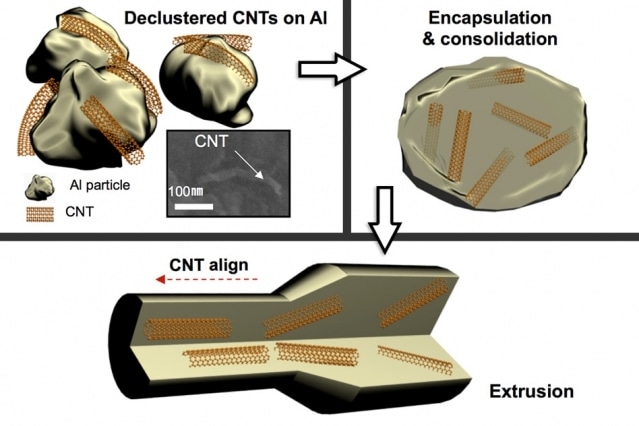Nuclear reactors tend to have a limited working life span. One reason for this is that metals subjected to the powerful radiation environment close to the core of the reactor become brittle and porous, resulting in cracking and failure. A team of researchers from MIT and other organizations has discovered that in a few reactors the introduction of a small quantity of carbon nanotubes to the metal can drastically slow down this breakdown process.
 The metal with carbon nanotubes uniformly dispersed inside “is designed to mitigate radiation damage” for long periods without degrading, Kang Pyo So says. Pictured is an example of how the researchers created aluminum with carbon nanotubes inside. Courtesy of the researchers
The metal with carbon nanotubes uniformly dispersed inside “is designed to mitigate radiation damage” for long periods without degrading, Kang Pyo So says. Pictured is an example of how the researchers created aluminum with carbon nanotubes inside. Courtesy of the researchers
This technique has turned out to only be successful for aluminum, restricting its operations to the lower-temperature environments present in research reactors. However the team highlight that the technique is also suitable for applications in the higher-temperature alloys utilized in commercial reactors.
The results of the study are explained in Nano Energy, in a paper by MIT Professor Ju Li, postdocs Kang Pyo So and Mingda Li, research scientist Akihiro Kushima, and 10 other researchers from MIT, Texas A&M University, and universities in Argentina, Chile, and South Korea.
In addition to the use in research reactor components, aluminum is also currently used in spacecraft and nuclear batteries, and it has been established as a suitable material for nuclear waste storage containers. Ju Li, the Battelle Energy Alliance Professor of Nuclear Science and Engineering and a professor of materials science and engineering, explains that a number of vital benefits can be obtained by enhancing aluminum’s operating lifetime.
Long-Term Stability
The metal, consisting of uniformly scattered carbon nanotubes “is designed to mitigate radiation damage” for long periods without degrading, says Kang Pyo So.
The researchers explained that helium from radiation transmutation settles inside metals and allows the material to develop small bubbles all through the grain boundaries and gradually becomes more fragile. Even though the nanotubes make up a tiny fraction of the volume, less than 2%, it is still capable of forming a percolating, 1-D transport network, to offer pathways for the helium to escape out of, instead of being confined within the metal where it could continue to cause damage.
Testing highlighted that the carbon nanotubes in the metal, after exposure to radiation, are capable of being chemically adjusted to carbides, but they continue to maintain their slender shape.
Almost like insects trapped in amber. It’s quite amazing — you don’t see a blob; they retain their morphology. It’s still one-dimensional.
Ju Li, Professor, MIT
A huge portion of the complete interfacial area of the 1-D nanostructures offer a way to recombine radiation-induced point defects in the metal, modifying a process that also results in embrittlement. The research team highlighted that the 1-D structure was capable of surviving up to 70 DPA of radiation damage. (DPA is a unit, which highlights how many times, on average, every single atom present in the crystal lattice is sent out of its site by radiation, so 70 DPA represents a lot of radiation damage.)
[Following radiation exposure] we see pores in the control sample, but no pores [in the new material] and mechanical data shows it has much less embrittlement.
Ju Li, Professor, MIT
Based on a specific amount of exposure to radiation, the tests revealed that the amount of embrittlement was decreased to about five to tenfold.
The team pointed out that the novel material requires only a small amount of carbon nanotubes (CNTs) — approximately 1% by weight added to the metal— and they are less costly to develop and process. The composite can be developed at a very low cost using standard industrial methods, and are already being developed in a large scale by automotive industry manufacturers based in Korea.
Strength and Resilience
The team states that even before radiation exposure, the addition of the small amount of nanotube enhances the material’s strength by 50% and upgrades its tensile ductility, which is its ability to deform without breaking.
“This is a proof of principle,” says Kang Pyo So. Initially, the researchers used aluminum for a number of tests, but they now plan to use zirconium to carry out similar tests. Zirconium is a metal that is often used for high-temperature reactor applications, like the cladding of nuclear fuel pellets. “We think this is a generic property of metal-CNT systems,” he says.
This is a development of considerable significance for nuclear materials science, where composites — particularly oxide dispersion-strengthened steels — have long been considered promising candidate materials for applications involving high temperature and high irradiation dose. [This new composite material] proves remarkably stable under prolonged irradiation, indicating that the material is able to self-recover and partially retain its original properties after exposure to high irradiation dose at room temperature. The fact that the new material can be produced at relatively low cost is also an advantage.
Sergei Dudarev, Professor of Materials Science, Oxford University
Sergei Kucheyev, a physicist at the Lawrence Livermore National Laboratory who also was not involved in this research, says, “These results could have important technological implications. They also point to our still-limited understanding of the physics of radiation defects at interfaces in technologically relevant regimes.”
The team also included researchers Sangtae Kim, Yang Yang, and Ziqiang Wang at MIT; Di Chen and Shao Lin at Texas A&M University; Jong Gil Park and Young Hee Lee at the Institute for Basic Science in South Korea; Rafael Gonzalez and Miguel Kiwi at the University of Chile; and Eduardo Bringa at the National University of Cuyo, in Argentina.
The U.S. Department of Energy and the National Research Foundation of Korea funded the study.